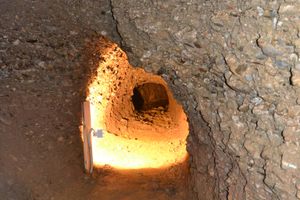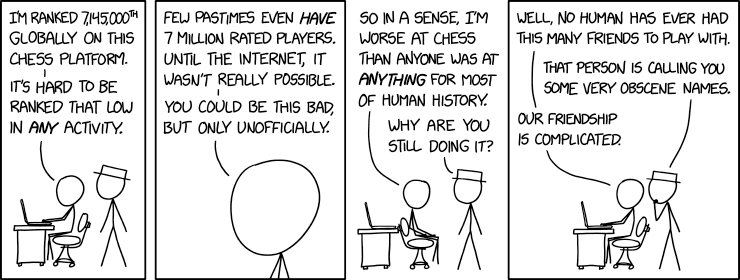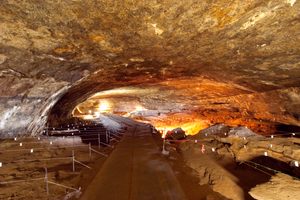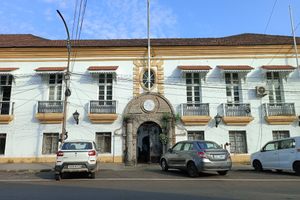https://archiveofourown.org/admin_posts/31876

The Policy & Abuse committee (PAC) is responsible for enforcing the AO3 Terms of Service (TOS). To help users better understand the TOS, we're posting a weekly spotlight series about the TOS and our policies. We'll also be reading comments and answering questions on this and our other spotlight posts.
For our last post in this series, we'll be talking about our non-commercialization policy. AO3 doesn't allow users to engage in commercial promotion of any type, which includes everything from paywalls to tip jars, and quite a lot in between. In this post, we'll discuss why AO3 doesn't allow commercialization, what kinds of activities are considered to be commercial promotion, and what to do if you see commercial promotion on AO3.
Don't go looking for things to report.
Please do not start searching for works to report after reading this post. We know that commercial promotion frequently appears on AO3. However, when people deliberately search for works to report, we end up getting a lot of duplicate tickets about works that have already been reported. Every ticket we receive is reviewed by a PAC volunteer, so we only need one report in order to investigate an issue. We know it seems like sites only respond to mass reports, but on AO3, duplicate and mass reports increase the time it takes our volunteers to investigate.
What is commercial promotion?
Commercial promotion covers all references or links to commercial sites, monetized features of non-commercial sites, and anything else that makes it clear someone is asking for or has received financial contributions.
On AO3, you can't encourage anyone to give other people money, or talk about anyone having given people money in the past. This applies whether you are promoting yourself or a friend, or even if you're collecting donations for other people or causes. If there is money changing hands, then it likely violates AO3's TOS.
AO3 is a non-commercial space.
AO3 was created and is managed by the Organization for Transformative Works (OTW), a nonprofit organization committed to the defense and protection of fanworks from commercial exploitation and legal challenges. The OTW is entirely staffed by unpaid volunteers, and AO3 is itself entirely non-commercial. No one involved in AO3's creation or management profits from it. The site is made available free of charge to all fans who wish to share their works with other fans and fan communities.
We understand that many people today choose to monetize their creative activities. However, in order to keep AO3 as the non-commercial space it was designed to be, users are not permitted to engage in any commercial activity on the site.
When you use AO3, you agree to follow our Terms of Service, which includes the non-commercialization policy. This applies to all parts of the site, whether you're posting a work based on an existing source or creating content entirely original to you.
AO3's non-commercialization policy applies to the entire site.
Real-world commercialization is banned everywhere on AO3. This includes:
- Profile pages
- Usernames, pseuds, and pseud descriptions
- Works (including all tags, beginning or end notes, chapter notes, summaries, and titles)
- Series (including titles, summaries, descriptions, and notes)
- Bookmarks (including tags and notes)
- Comments
- Prompt memes, gift exchanges, and other collections
- Any other part of AO3
It's okay for fictional characters in fanworks to talk about fictional monetization. For example, it's fine if a character has a fictional OnlyFans or Patreon within the story, as long as that commercial reference doesn't direct the reader to a real-world OnlyFans or Patreon account for the work creator or anyone else.
What are some examples of commercial activities?
There is a wide variety of things that are not allowed under AO3's non-commercialization rules.
Links or references to any commercial site or service. A "commercial site" is any site whose primary purpose is to facilitate the transfer of money. This includes, but is not limited to:
- Storefronts like Amazon or Etsy
- Crowd fundraisers like Kickstarter or GoFundMe
- Tip jars or membership subscriptions like Ko-Fi or Patreon
- Payment platforms like PayPal or Venmo
Links or references to the monetized features of non-commercial sites. This covers any site that has features you can enable or opt-in to earn revenue, but the primary purpose of the site is social media, sharing artwork, or anything else that isn't inherently payment-focused. This includes, but is not limited to:
- Paywalls or early-access content like Wattpad Paid Stories or Webtoon Canvas
- Storefronts like DeviantArt Shop or Instagram Shop
- Tip jars or membership subscriptions like TikTok Donation Stickers or Twitch Prime
Previews and other promotions for paid content. This covers situations like excerpts or teasers shared in an attempt to entice people to purchase a book or become a paying subscriber. It also includes references to paywalled or early-access content (e.g. "Patreon subscribers get the new chapter one week early before I post it on AO3").
Advertising content or services involving an exchange of money, such as buying merchandise, collecting donations, offering paid commissions, or selling published works.
Any other language which one might interpret as requesting or having requested financial contributions, whether for yourself or others. This covers indirect references, euphemisms, or other language intended to get around the TOS. Some examples of this include:
- Thanks for the coffee!
- My ☕ username is the same as my username here
- This chapter is brought to you by my patrons
- You know where to find me if you want early or bonus chapters
- Check out my Twitter to learn how you can donate to me
since I'm not allowed to discuss it here
- If you want to hear more about my ideas, talk about fandom, or find more of my stuff for a coin, visit my Tumblr
Solicitation is not allowed, whether it's for yourself or on behalf of someone else.
Commercial activity is not permitted on AO3. It doesn't matter if you're promoting yourself or a friend, or even if you're collecting donations for other people or causes.
This means that if you paid an artist to create artwork for your fanfic, you're not allowed to mention that they have a Patreon or use any other language that suggests people should also commission or donate to them. If you like a book by a particular author, you are certainly welcome to gush about what a great book it is, but you can't link to the Amazon page where it's for sale or encourage others to buy it.
What is the difference between a commercial site and a non-commercial site that has monetization features?
As mentioned above, a commercial site is a platform that is first and foremost intended to facilitate the exchange of money. For example, while you can use Ko-Fi as a blog, the site's primary purpose is to encourage people to give each other money. Ko-Fi's social features are secondary to its purpose as a donation and paid membership platform. This means you cannot link to or mention your or anyone else's actual Ko-Fi on AO3 whatsoever.
An example of a non-commercial site that has monetization features is DeviantArt, an art gallery that is mainly intended as a place to share artworks. DeviantArt also allows its users to opt-in to additional monetization features, such as the DeviantArt Shop. Because DeviantArt's paid features are both optional and not the primary reason people use the site, you can talk about or link to DeviantArt on AO3 – as long as you aren't directing anyone to a paywalled post or referencing DeviantArt's paid features in any way.
Can I link or mention a social media site where I talk about making money or collecting donations?
You're allowed to link or mention social media like Tumblr or personal websites like WordPress, even if you sometimes post about commercial activities on those sites. However, you cannot reference commercial promotion on AO3 itself, nor may you link, mention, or give instructions for finding an account, page, or post that is solely promoting paid content.
Statements such as "Follow me on social media" or "Check out my Linktree" are fine. Directing people to an Amazon author page or to the Ko-fi link in your Twitter bio would not be allowed. This includes things like "Check out my Linktree to learn how you can support me" in cases where you are clearly referring to monetary support.
Can I post a fanwork created for a charity drive or for-profit zine?
While you cannot promote, solicit, or otherwise ask for donations on AO3, you are allowed to add your work to a collection or otherwise briefly mention why you created a fanwork, as long as you do so in a non-commercial manner. This means you can say "This was created for [Event]" or "Originally Written for [Name of Person/Zine]" as long as you do not directly link to a donation page or ask others to donate to them.
Keep in mind we also do not permit mentions of monetary transactions, regardless of when they occurred. A note such as "This was a $100 bid for Fandom Trumps Hate" would still be considered commercialization.
I've seen authors say their works are commissions. Is this allowed?
You are allowed to gift your work to someone else or otherwise briefly mention why you created a fanwork, as long as you do so in a non-commercial manner. Because not all commissioned fanworks were created for pay, we do permit usage of the word "commission" as long as there is no indication that a monetary transaction was involved in the creation of the work or that you are available to create other paid commissions.
For example, phrasing like "This is a commission for X" is acceptable, but "Commission for my Gold Tier Patron, Julie" or "My client agreed to let me post the first chapter of their commission" isn't. The context makes it clear that both "patron" and "client" are references to a paying sponsor.
I've seen others ask for donations or advertise paid commissions. Why can't I?
As our TOS FAQ explains, we don't review content until it's reported to us. You may have seen somebody else mentioning their paywalled content or otherwise engaging in commercial activities on AO3, but that doesn't mean that it's allowed. All it means is that nobody has reported that content to us yet, or that we haven't finished processing the report.
What will happen if I get reported for commercial promotion?
First, we'll review the reported work to confirm that you violated our TOS by engaging in commercial activities on AO3. If we determine that you did, we'll send you an email telling you to remove the violating material.
If your work can be edited to fix the issue, you'll be asked to edit the work. Your work may be hidden from other users until you do. If you choose not to edit the work, or if your work cannot be edited into compliance with the TOS, it will be deleted.
PAC will only ever contact you by email, and only after we've determined that your work violates our Terms of Service. We will never comment on your work or contact you through social media. Please make sure to keep your account's email address up to date and check it regularly (including your spam folder), or else you may miss our warning email.
If you repeatedly post works that violate our commercial promotion policies, you may be temporarily suspended. Continuing to violate the TOS will result in your being permanently banned from AO3. You can learn more about warnings and suspensions in our TOS FAQ.
What should I do if I encounter commercial activity on AO3?
You can give the creator a heads up by politely commenting on their work and linking to the TOS FAQ or this post. Alternatively, you can report the work to us.
What about spam comments?
The best way to deal with spam comments, commercial or otherwise, depends on whether the comments are from registered accounts or guests.
How do I report commercial activity?
Although we ask that you do not deliberately seek out commercial promotion to report, if you come across commercial activity while browsing, you can report it using the Policy Questions & Abuse Reports form, which is linked at the bottom of every page on AO3.
Please don't report more than one user at a time or submit multiple reports about the same user. When reporting multiple works by the same user, please submit only one report with links to each work you're reporting, so that all information about that user is in the same place.
Please tell us exactly where in the work the commercialization is. The best way to do this is to give us a description or short quote that we can search for in order to immediately find the content. If you are reporting multiple works by the same creator, please group all the works into one report and provide this information for each work.
For example, a report of commercial promotion might look like this:
Link to the page you are reporting: https://archiveofourown.org/works/00000000
Brief summary of Terms of Service violation: Commercial promotion
Description of the content you are reporting:
This work by USERNAME advertises a ko-fi in the end notes of chapter 3.
If you are reporting additional works, please include all relevant links and other information in your report description:
Description of the content you are reporting:
This work by USERNAME advertises a ko-fi in the end notes of chapter 3.
Some of their other works also contain commercial promotion:
https://archiveofourown.org/works/23456789 encourages readers to purchase their book on Amazon: "If you're curious what else I've been working on or want to support me elsewhere, check out my new short story on Kindle Unlimited!"
https://archiveofourown.org/works/34567890 contains an embedded image with a Patreon watermark. Underneath, the sentence "If you want more like this, click here" takes you to their commissions price sheet.
You can add more details if you like, but this example provides the basic information we need:
- Who posted the commercial promotion: Tell us their username or if the work is anonymous or orphaned.
- Where we can find the work(s): Enter one URL in the "Link to the page you are reporting" field, and (if applicable) include links to any other violating works in the description of your report.
- What violates the TOS: Explain why you think commercial promotion has occurred, for example by including a quote and/or providing context for a comment exchange. A brief description of the situation is fine; you don't need to be very detailed or quote an entire TOS or FAQ section.
You'll receive an automatic email confirming that we received your report, and our volunteers will investigate when they get a chance. Please be patient and do not submit another report about the same work. While PAC investigates every report we receive, it can take several months for us to process a report, and not every report will receive a reply.
What if I have more questions about commercial promotion?
PAC follows a strict confidentiality policy. Therefore, while you are welcome to ask general questions in the comments of this post, we will not give information on specific cases, publicly rule on a work, or update you on the status of a report you have already submitted. Comments on this post that discuss specific works or users will be removed.
If you think you've found commercial promotion on AO3, or if you want to know whether a particular work contains commercial promotion, please report the work to us as described above. For more information, you can read our TOS FAQ on Commercial Promotion.
If you are still uncertain, you can comment below or submit a question through the Policy Questions & Abuse Reports form.
https://archiveofourown.org/admin_posts/31876













